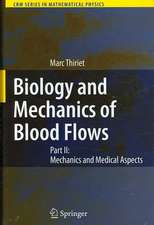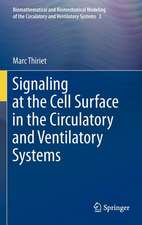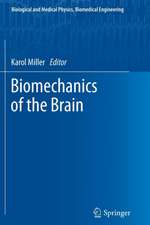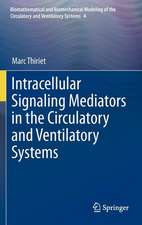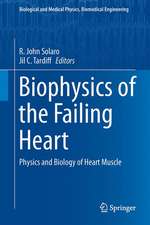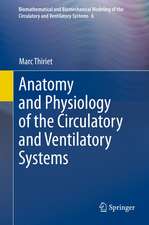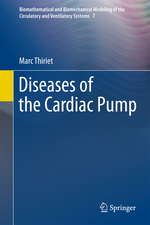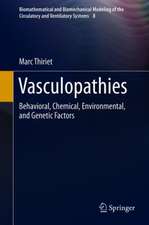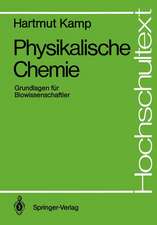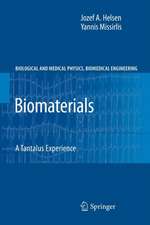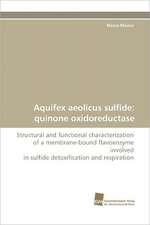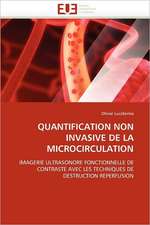Tissue Functioning and Remodeling in the Circulatory and Ventilatory Systems: Biomathematical and Biomechanical Modeling of the Circulatory and Ventilatory Systems, cartea 5
Autor Marc Thirieten Limba Engleză Hardback – 11 ian 2013
| Toate formatele și edițiile | Preț | Express |
|---|---|---|
| Paperback (1) | 1249.31 lei 6-8 săpt. | |
| Springer – 23 aug 2016 | 1249.31 lei 6-8 săpt. | |
| Hardback (1) | 1269.36 lei 6-8 săpt. | |
| Springer – 11 ian 2013 | 1269.36 lei 6-8 săpt. |
Preț: 1269.36 lei
Preț vechi: 1547.99 lei
-18% Nou
Puncte Express: 1904
Preț estimativ în valută:
242.92€ • 252.68$ • 200.55£
242.92€ • 252.68$ • 200.55£
Carte tipărită la comandă
Livrare economică 12-26 aprilie
Preluare comenzi: 021 569.72.76
Specificații
ISBN-13: 9781461459651
ISBN-10: 1461459656
Pagini: 984
Ilustrații: XXI, 962 p.
Dimensiuni: 155 x 235 x 58 mm
Greutate: 1.93 kg
Ediția:2013
Editura: Springer
Colecția Springer
Seria Biomathematical and Biomechanical Modeling of the Circulatory and Ventilatory Systems
Locul publicării:New York, NY, United States
ISBN-10: 1461459656
Pagini: 984
Ilustrații: XXI, 962 p.
Dimensiuni: 155 x 235 x 58 mm
Greutate: 1.93 kg
Ediția:2013
Editura: Springer
Colecția Springer
Seria Biomathematical and Biomechanical Modeling of the Circulatory and Ventilatory Systems
Locul publicării:New York, NY, United States
Public țintă
ResearchCuprins
Preface.- Chapter 1: Blood.- Chapter 2: Hematopoiesis.- Chapter 3: Blood Cells.- Chapter 4: Lymph Drainage.- Chapter 5: Cardiomyocytes.- Chapter 6: Heart Wall.- Chapter 7: Vessel Wall.- Chapter 8: Smooth Myocytes.- Chapter 9: Vascular Endothelium.- Chapter 10: Vascular Growth.- Chapter 11: Tissue Development, Repair, and Remodeling.- Chapter 12: Airway Surface Liquid and Respiratory Mucus.- Chapter 13: Surfactant.- Chapter 14: Conclusion.- References.- List of Currently Used Prefixes and Suffixes.- List of Aliases.- Complementary Lists of Notations.- Index.
Textul de pe ultima copertă
The volumes in this authoritative series present a multidisciplinary approach to modeling and simulation of flows in the cardiovascular and ventilatory systems, especially multiscale modeling and coupled simulations. Volume 5 is devoted to cells, tissues, and organs of the cardiovascular and ventilatory systems with an emphasis on mechanotransduction-based regulation of flow. The blood vessel wall is a living tissue that quickly reacts to loads applied on it by the flowing blood. In any segment of a blood vessel, the endothelial and smooth muscle cells can sense unusual time variations in small-magnitude wall shear stress and large-amplitude wall stretch generated by abnormal hemodynamic stresses. These cells respond with a short-time scale (from seconds to hours) to adapt the vessel caliber. Since such adaptive cell activities can be described using mathematical models, a key objective of this volume is to identify the mesoscopic agents and nanoscopic mediators required to derive adequate mathematical models. The resulting biomathematical models and corresponding simulation software can be incorporated into platforms developed in virtual physiology for improved understanding and training.
Reviews structure and function of major constituents of the circulatory and respiratory apparatus
Describes major cellular processes involved in signaling, interactions, and adaptive responses of physiological conduits
Integrates biology, chemistry, and physics for the multidisciplinary exploration and modeling of physiological flows
Focuses on mechanotransduction-induced regulation
Reviews structure and function of major constituents of the circulatory and respiratory apparatus
Describes major cellular processes involved in signaling, interactions, and adaptive responses of physiological conduits
Integrates biology, chemistry, and physics for the multidisciplinary exploration and modeling of physiological flows
Focuses on mechanotransduction-induced regulation
Caracteristici
Reviews structure and function of major constituents of the circulatory and respiratory apparatus Describes major cellular processes involved in signaling, interactions, and adaptive responses of physiological conduits Integrates biology, chemistry, and physics for the multidisciplinary exploration and modeling of physiological flows Focuses on mechanotransduction-induced regulation Includes supplementary material: sn.pub/extras








